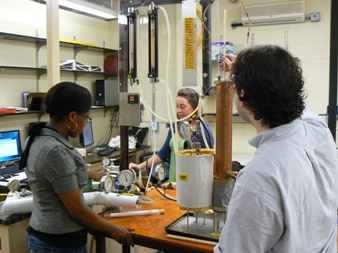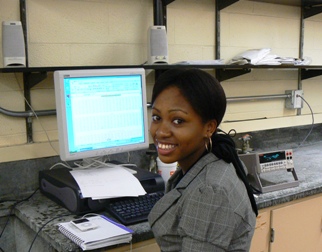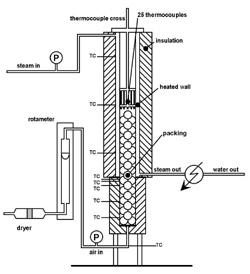
Heat transfer experiments are carried out in packed tubes of different diameters, with many different shapes
and sizes of packings. The tubes were designed to be modular, so that different diameter tubes could
be easily placed and connected to air flow, cooling water or steam and data acquisition at the experimental station.
In the picture to the left the summer 2008 research group checks out the new heat transfer column
with air pre-heated by an electrical heater and a water cooling jacket, with thermocouple connectors to the
data acquisition system. Pressurized hot air flows through the column from the bottom through an unheated flow
calming section, before entering the cooled test section. The packing is easily dumped and replaced at the end
of an experimental run.

The picture to the right shows 2008 summer student Winnie Nabea with the new data acquisition system that she
helped set up and was using to take heat transfer data. The system is a Keithley Instruments Inc. Model 2700
DMM/DATA ACQUISITION SYSTEM. The data box contains two modules, each capable of supporting up to 20
thermocouples. The interface to the user is via an ExceLinx spreadsheet-based application, allowing
collection, storage and data display.

The picture to the left shows a diagram of the older steam-heated column with the wall thermocouple locations and the
thermocouple cross inserted in the column. Also shown are the air and steam lines and a packing of
spheres for a tube-to-particle diameter ratio of two. Several temperature profiles can be acquired using thermocouples embedded in the
column wall for axial wall temperature profiles and thermocouples in the cross for radial profiles inside
the column. Different depths of packing may be used, to give radial temperatures at different axial bed heights.
The thermocouple cross may be rotated to provide a series of radial profiles at selected angular positions.
Measurements, transient or steady state, are recorded using a computer system hooked up to the thermocouples.
An experimental setup for measuring mass transfer from the wall of a packed tube is also available in the lab.,
but has not been used in recent years. For a description of the last project to use it, see
[Dixon, A.G., Arias, J. and Willey, J., 2003].
|


